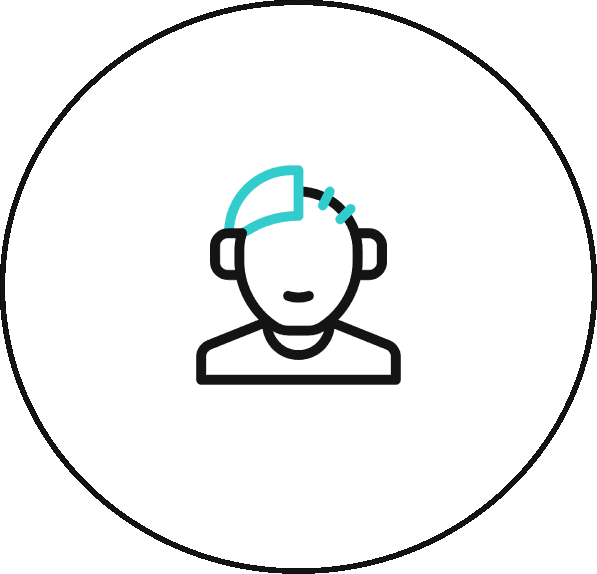Seborrheic Dermatitis
Seborrheic Dermatitis![]()
What is Seborrheic Dermatitis
Seborrheic dermatitis is a common skin condition that affects millions worldwide, causing redness, itching, and flakiness primarily on the scalp but also on oily areas like the face and chest. Understanding its causes, symptoms, and treatment options is crucial for managing this condition effectively.At AlloRoots Hair Restoration, we understand the challenges and frustrations that come with managing this condition, which is why we’re dedicated to providing you with valuable information and resources to help you effectively manage seborrheic dermatitis.
Causes of Seborrheic Dermatitis:
- Malassezia Overgrowth: An overgrowth of the yeast Malassezia on the skin’s surface can trigger inflammation, leading to seborrheic dermatitis.
- Genetic Predisposition: Family history plays a role, with genetics influencing susceptibility to the condition.
- Hormonal Changes: Fluctuations in hormone levels, such as during puberty or pregnancy, can contribute to flare-ups.
- Environmental Factors: Cold, dry weather or excessive heat and humidity can exacerbate symptoms.
Symptoms of Alopecia Areata:
Redness and inflammation
Flaky, greasy patches of skin
Itching or burning sensation
Dandruff-like flakes on the scalp
Crusting or scaling around the nose, eyebrows, or eyelids
Seborrheic Dermatitis![]()
![]()
![]()
![]()
![]()
Effective Treatment Options
- Medicated Shampoos: Over-the-counter shampoos containing ketoconazole, selenium sulfide, or zinc pyrithione can alleviate symptoms.
- Topical Treatments: Corticosteroid creams or ointments help reduce inflammation and itching.
- Antifungal Creams: Prescription antifungal treatments target the yeast responsible for seborrheic dermatitis.
- Trigger Avoidance: Identifying and avoiding triggers like stress or harsh weather conditions can prevent flare-ups.
- Moisturization: Regular use of a gentle, fragrance-free moisturizer soothes dry, irritated skin.


Seborrheic Dermatitis![]()
![]()
![]()
![]()
![]()
Conclusion
While seborrheic dermatitis can be chronic, proper management is possible with the right approach. By understanding its causes, recognizing symptoms early, and implementing effective treatments, individuals can find relief and regain control over their skin health. Our team of dermatologist shares valuable tips and advice on skincare routines, trigger avoidance, and lifestyle modifications to help you minimize flare-ups and maintain healthy skin.
Why Choose Us?


Premier Surgeons: Expert alumni from AIIMS Delhi with 10+ years of experience.


Maximum Viability: Optimize graft survival with cutting-edge advanced Technology (Realtime Bio- Enhanced FUE)


Natural Hairline Design: Achieve the most natural hairline with 3000+ success stories.


Uncompromised Safety: 100% doctor-led surgeries with strict safety protocols.
Seborrheic Dermatitis![]()
![]()
![]()
![]()
![]()
Frequently Asked Questions
What is seborrheic dermatitis?
Seborrheic dermatitis is a chronic skin disease characterized by scaling patches, redness of the skin, and stubborn dandruff. It affects mainly oily areas of the body, such as the scalp, face, and chest.
What are the causes of seborrheic dermatitis?
Though the real cause of this disease is yet unknown, it is associated by experts with a combination of factors that include an overgrowth of the Malassezia yeast on the skin, anomalous immunological response, and excessive production of oil.
Is seborrheic dermatitis the same as dandruff?
Seborrheic dermatitis is actually an advanced form of dandruff. While dandruff itself is characterized by flaky skin on the scalp, in seborrheic dermatitis, the skin becomes red, inflamed, and scaly and can spread to areas such as the face, ears, and chest area.
Can seborrheic dermatitis be cured?
There is no cure for seborrheic dermatitis, only the management of its symptoms by proper treatment. This includes medicated shampoos, antifungal creams, and application of topical steroids to lessen inflammation and reduce symptoms.
What can trigger a seborrheic dermatitis flare-up?
Among the triggers are the following: emotional stress, cold and dry weather, hormonal changes, and some skin-care products. Maintaining regular skin care is the key to preventing flare-ups, besides keeping away from known triggers.
How is seborrheic dermatitis diagnosed?
A dermatologist usually diagnoses seborrheic dermatitis based on physical examination of the affected skin. He sometimes recommends a skin biopsy to exclude other conditions that look like it.
Are there any home remedies for seborrheic dermatitis?
Home remedies that incorporate coconut oil, apple cider vinegar, and tea tree oil may help to alleviate the symptoms of the condition, but always check with a healthcare professional before trying them, as not all might be suitable for everyone.
Reach Out for a Hair Transformation Today!
Contact Us.
Delhi: C-26, First Floor, Greater Kailash 1, New Delhi, 110048, India
Bhubaneswar: 2nd Floor, D 1 Square , Nandan Kanan Road , KIIT Square, Patia, Bhubaneswar, Odisha 751024
Uttarakhand: Gularbhoj Rd, near The Royal Gym, Dineshpur, Gurunanakpur, Uttarakhand 263160
Chennai: 39/2, RK Shanmugam Salai, Goutham Colony, K. K. Nagar, Chennai, Tamil Nadu 600078




